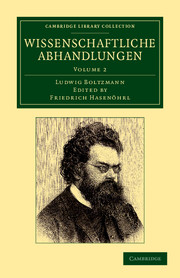Refine search
Actions for selected content:
10306 results in History of science: general interest
PARS SECUNDA (continuata), AUCTORUM NOMINA ALPHABETICE ORDINATA, ET SINGULORUM OPERA CONTINENS Pages 510-589
-
- Book:
- Bibliographia zoologiae et geologiae
- Published online:
- 05 October 2014
- Print publication:
- 04 July 2013, pp 510-589
-
- Chapter
- Export citation
PARS SECUNDA (Continuata), AUCTORUM NOMINA ALPHABETICE ORDINATA, ET SINGULORUM OPERA CONTINENS pages 162-312
-
- Book:
- Bibliographia zoologiae et geologiae
- Published online:
- 05 March 2014
- Print publication:
- 04 July 2013, pp 162-312
-
- Chapter
- Export citation
LIST OF SUBSCRIBERS
-
- Book:
- Bibliographia zoologiae et geologiae
- Published online:
- 05 October 2014
- Print publication:
- 04 July 2013, pp 611-626
-
- Chapter
- Export citation
PARS SECUNDA (Continuata), AUCTORUM NOMINA ALPHABETICE ORDINATA, ET SINGULORUM OPERA CONTINENS pages 312-375
-
- Book:
- Bibliographia zoologiae et geologiae
- Published online:
- 05 March 2014
- Print publication:
- 04 July 2013, pp 312-375
-
- Chapter
- Export citation
PARS SECUNDA (continuata), AUCTORUM NOMINA ALPHABETICE ORDINATA, ET SINGULORUM OPERA CONTINENS Pages 594-604
-
- Book:
- Bibliographia zoologiae et geologiae
- Published online:
- 05 October 2014
- Print publication:
- 04 July 2013, pp 594-604
-
- Chapter
- Export citation
PARS SECUNDA (continuata), AUCTORUM NOMINA ALPHABETICE ORDINATA, ET SINGULORUM OPERA CONTINENS Pages 589-593
-
- Book:
- Bibliographia zoologiae et geologiae
- Published online:
- 05 October 2014
- Print publication:
- 04 July 2013, pp 589-593
-
- Chapter
- Export citation
Bibliographia Zoologiæ et Geologiæ, Pars, I., Acta Societatum. Diaria et Tractatuum Syllogas continens
-
- Book:
- Bibliographia zoologiae et geologiae
- Published online:
- 05 March 2014
- Print publication:
- 04 July 2013, pp 1-86
-
- Chapter
- Export citation
PARS SECUNDA (continuata), AUCTORUM NOMINA ALPHABETICE ORDINATA, ET SINGULORUM OPERA CONTINENS Pages 589-589
-
- Book:
- Bibliographia zoologiae et geologiae
- Published online:
- 05 October 2014
- Print publication:
- 04 July 2013, pp 589-589
-
- Chapter
- Export citation
Frontmatter
-
- Book:
- Bibliographia zoologiae et geologiae
- Published online:
- 05 March 2014
- Print publication:
- 04 July 2013, pp i-x
-
- Chapter
- Export citation
PARS SECUNDA (Continuata), AUCTORUM NOMINA ALPHABETICE ORDINATA, ET SINGULORUM OPERA CONTINENS pages 375-492
-
- Book:
- Bibliographia zoologiae et geologiae
- Published online:
- 05 March 2014
- Print publication:
- 04 July 2013, pp 375-492
-
- Chapter
- Export citation
ADVERTISEMENT
-
- Book:
- Bibliographia zoologiae et geologiae
- Published online:
- 05 October 2014
- Print publication:
- 04 July 2013, pp vii-viii
-
- Chapter
- Export citation
REPORT COUNCIL OF THE RAY SOCIETY
-
- Book:
- Bibliographia zoologiae et geologiae
- Published online:
- 05 October 2014
- Print publication:
- 04 July 2013, pp 605-608
-
- Chapter
- Export citation
PARS SECUNDA (Continuata), AUCTORUM NOMINA ALPHABETICE ORDINATA, ET SINGULORUM OPERA CONTINENS
-
- Book:
- Bibliographia zoologiae et geologiae
- Published online:
- 05 March 2014
- Print publication:
- 04 July 2013, pp 1-162
-
- Chapter
- Export citation
List of Abbreviations
-
- Book:
- Bibliographia zoologiae et geologiae
- Published online:
- 05 March 2014
- Print publication:
- 04 July 2013, pp xiii-xxiv
-
- Chapter
- Export citation
PARS SECUNDA (continuata), AUCTORUM NOMINA ALPHABETICE ORDINATA, ET SINGULORUM OPERA CONTINENS Pages 468-471
-
- Book:
- Bibliographia zoologiae et geologiae
- Published online:
- 05 October 2014
- Print publication:
- 04 July 2013, pp 468-471
-
- Chapter
- Export citation
PARS SECUNDA (continuata), AUCTORUM NOMINA ALPHABETICE ORDINATA, ET SINGULORUM OPERA CONTINENS Pages 472-510
-
- Book:
- Bibliographia zoologiae et geologiae
- Published online:
- 05 October 2014
- Print publication:
- 04 July 2013, pp 472-510
-
- Chapter
- Export citation
‘The sceptre of her pow'r’: nymphs, nobility, and nomenclature in early Victorian science
-
- Journal:
- The British Journal for the History of Science / Volume 47 / Issue 1 / March 2014
- Published online by Cambridge University Press:
- 21 June 2013, pp. 67-94
- Print publication:
- March 2014
-
- Article
- Export citation

Wissenschaftliche Abhandlungen
-
- Published online:
- 05 June 2013
- Print publication:
- 23 August 2012
- First published in:
- 1909

Wissenschaftliche Abhandlungen
-
- Published online:
- 05 June 2013
- Print publication:
- 23 August 2012
- First published in:
- 1909
Christine Ferguson, Determined Spirits: Eugenics, Heredity and Racial Regeneration in Anglo-American Spiritualist Writing, 1848–1930. Edinburgh: Edinburgh University Press, 2012. Pp. x+230. ISBN 978-0-7486-3965-6. £70.00 (hardback).
-
- Journal:
- The British Journal for the History of Science / Volume 46 / Issue 2 / June 2013
- Published online by Cambridge University Press:
- 13 May 2013, pp. 351-352
- Print publication:
- June 2013
-
- Article
- Export citation
